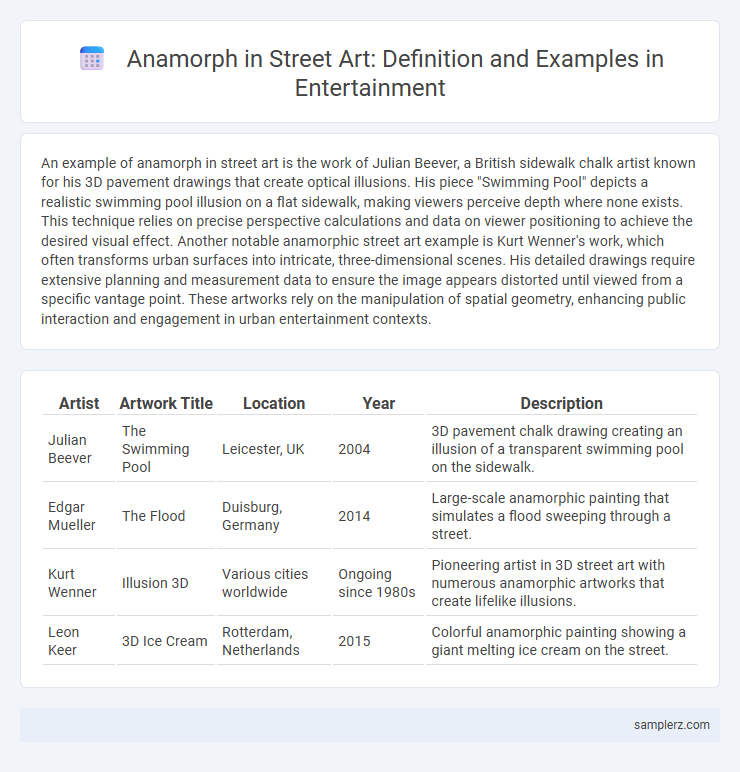An example of anamorph in street art is the work of Julian Beever, a British sidewalk chalk artist known for his 3D pavement drawings that create optical illusions. His piece "Swimming Pool" depicts a realistic swimming pool illusion on a flat sidewalk, making viewers perceive depth where none exists. This technique relies on precise perspective calculations and data on viewer positioning to achieve the desired visual effect. Another notable anamorphic street art example is Kurt Wenner's work, which often transforms urban surfaces into intricate, three-dimensional scenes. His detailed drawings require extensive planning and measurement data to ensure the image appears distorted until viewed from a specific vantage point. These artworks rely on the manipulation of spatial geometry, enhancing public interaction and engagement in urban entertainment contexts.
Table of Comparison
| Artist | Artwork Title | Location | Year | Description |
|---|---|---|---|---|
| Julian Beever | The Swimming Pool | Leicester, UK | 2004 | 3D pavement chalk drawing creating an illusion of a transparent swimming pool on the sidewalk. |
| Edgar Mueller | The Flood | Duisburg, Germany | 2014 | Large-scale anamorphic painting that simulates a flood sweeping through a street. |
| Kurt Wenner | Illusion 3D | Various cities worldwide | Ongoing since 1980s | Pioneering artist in 3D street art with numerous anamorphic artworks that create lifelike illusions. |
| Leon Keer | 3D Ice Cream | Rotterdam, Netherlands | 2015 | Colorful anamorphic painting showing a giant melting ice cream on the street. |
Introduction to Anamorph Street Art
Anamorph street art transforms ordinary urban surfaces into striking optical illusions that change perspective based on the viewer's angle. Renowned examples include Julian Beever's sidewalk drawings that create 3D scenes seemingly rising from flat pavements. This technique leverages distorted imagery and precise perspective to engage passersby in immersive visual experiences.
Famous Examples of Anamorphic Murals
Famous examples of anamorphic murals include Leon Keer's 3D street art, which creates interactive illusions like a towering water spout or giant playing cards. Edgar Mueller's realistic flood scenes transform pavements into immersive environments that captivate viewers with their depth and detail. These masterpieces leverage perspective techniques to engage audiences in urban settings, blending art and public space innovatively.
Interactive Anamorphs on City Streets
Interactive anamorphs on city streets transform flat surfaces into dynamic, three-dimensional experiences that engage passersby in immersive visual storytelling. Street artists such as Leon Keer and Kurt Wenner specialize in creating large-scale anamorphic illusions that appear to rise from pavements or plunge into the ground, inviting viewers to interact and become part of the art. These installations use precise perspective and viewer positioning, amplifying urban environments into spectacular, participatory canvases that redefine public space entertainment.
Optical Illusions in Public Spaces
Anamorphic street art transforms public spaces through mind-bending optical illusions that appear distorted until viewed from a specific angle. Iconic examples include Leon Keer's 3D chalk drawings, which utilize perspective to create immersive scenes that engage passersby in urban environments. These illusions not only challenge visual perception but also invite interactive experiences, making public art both dynamic and accessible.
Creating 3D Effects on Flat Surfaces
Anamorphic street art transforms flat surfaces into striking 3D illusions by manipulating perspective and distortion, captivating viewers with lifelike depth. Artists like Leon Keer and Edgar Muller specialize in creating these optical illusions on sidewalks and walls, making objects appear to float or emerge from the surface. This technique relies on precise calculations and viewer positioning to bring flat images to dynamic life in public spaces.
Iconic Street Artists Using Anamorphs
Iconic street artists like Kurt Wenner and Leon Keer have revolutionized urban spaces with their mesmerizing anamorphic illusions that appear three-dimensional when viewed from specific angles. Wenner's intricate chalk drawings on pavement create stunning visual depth, while Keer's interactive murals blend reality and fantasy, captivating global audiences. These artists push the boundaries of street art, transforming ordinary surfaces into immersive experiences through expertly crafted anamorphic techniques.
Anamorphic Street Art for Urban Revitalization
Anamorphic street art transforms ordinary urban spaces into dynamic, immersive experiences by using distorted images that reveal hidden perspectives when viewed from specific angles. This technique revitalizes neglected city areas, attracting tourists and fostering community engagement through visually striking and interactive murals. Notable examples include the 3D pavement art in Lisbon and the optical illusion walls in Berlin, which both enhance urban aesthetics and encourage cultural tourism.
Temporary vs Permanent Anamorphic Installations
Temporary anamorphic street art, such as Kurt Wenner's pavement 3D illusions, captivates audiences with its fleeting impact and interactive engagement, often dissolving with weather or time. Permanent anamorphic installations like Felice Varini's architectural projections create lasting spatial illusions that redefine public spaces and invite continuous reinterpretation. These contrasting approaches highlight the dynamic relationship between impermanence and durability in anamorphic street art, influencing urban aesthetics and public interaction.
Community Engagement Through Anamorph Art
Anamorph art in street murals transforms public spaces into interactive experiences that captivate local communities and encourage collective participation. By distorting images that only resolve from specific vantage points, these artworks foster social interaction and shared discovery among passersby. Notable examples include the 3D pavement paintings in Bristol and the optical illusion murals in Sao Paulo, where community workshops often accompany the installations to deepen engagement and cultural connection.
The Future of Anamorph in Street Culture
Anamorphic street art, exemplified by works like Edgar Muller's 3D sidewalk paintings, transforms urban spaces into immersive visual experiences that challenge perception and engage passersby. Advances in augmented reality technologies are expected to enhance these optical illusions, integrating digital layers with physical murals to create interactive, evolving artworks. The future of anamorph in street culture lies in blending traditional techniques with innovation, expanding its impact through social media and virtual exhibitions.

example of anamorph in street art Infographic
 samplerz.com
samplerz.com